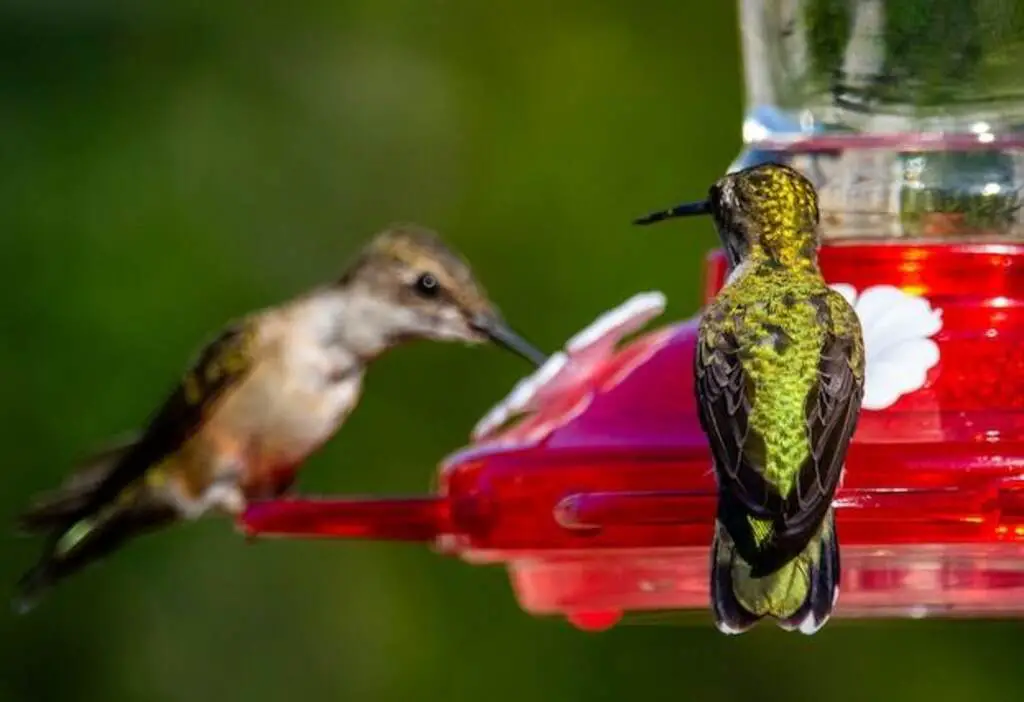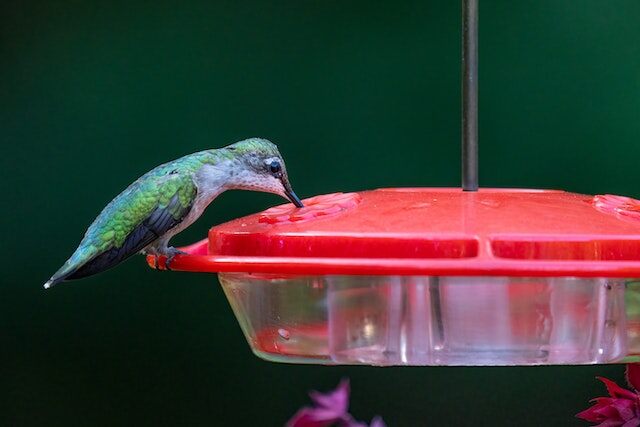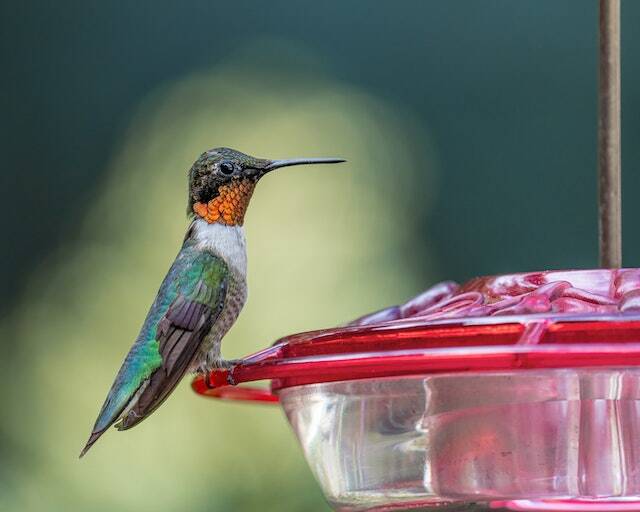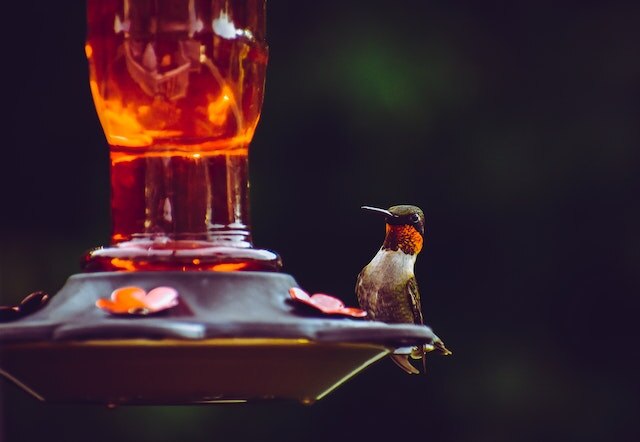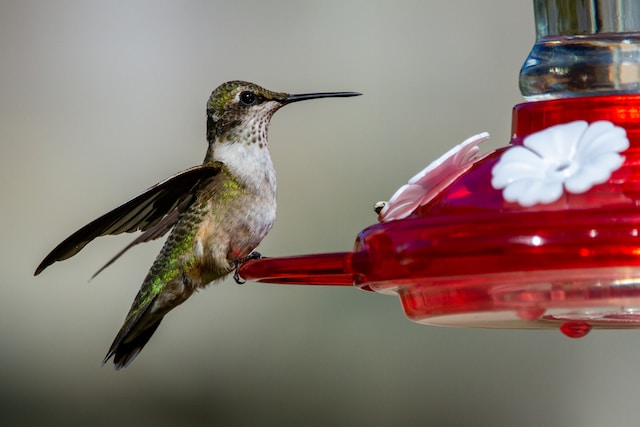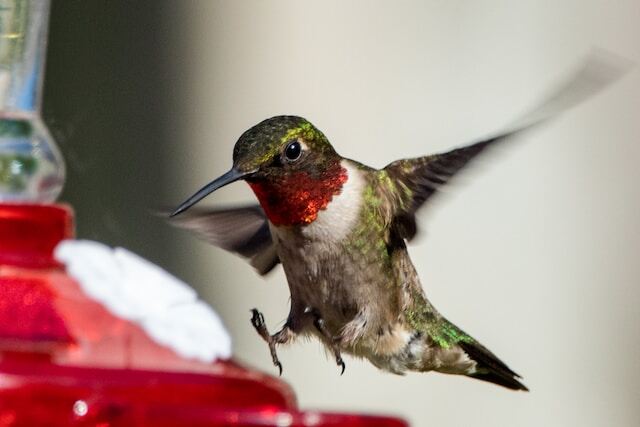Hummingbirds are a delight to watch, with their vibrant colors and frenzied fluttering. However, these small birds can also be surprisingly aggressive, especially when it comes to protecting their food source.
Have you ever wondered why hummingbirds fight over the feeder? In this article, we will explore the territorial behavior of hummingbirds and the reasons behind their aggression.
Table of Contents
- 1 Key Takeaways:
- 2 Why Do Hummingbirds Fight Over the Feeder?
- 3 Territorial Behaviors in Hummingbirds
- 4 Feeding Habits of Hummingbirds
- 5 The Role of Competition in Hummingbird Aggression
- 6 Environmental Factors and Feeder Placement
- 7 The Importance of Multiple Feeders
- 8 Feeder Design and Features
- 9 Providing Adequate Food and Nectar
- 10 Natural Ways to Deter Hummingbird Aggression
- 11 Conclusion
- 12 FAQs: Why Hummingbirds Fight Over the Feeder?
- 12.1 Why do hummingbirds fight over the feeder?
- 12.2 What causes hummingbird feeder aggression?
- 12.3 How can I manage hummingbird territorial disputes?
- 12.4 How can I reduce hummingbird aggression at the feeder?
- 12.5 What role does competition play in hummingbird aggression?
- 12.6 How does environmental factors and feeder placement impact hummingbird aggression?
- 12.7 Why are multiple feeders important?
- 12.8 What feeder design and features can help manage hummingbird aggression?
- 12.9 How can I provide adequate food and nectar for hummingbirds?
- 12.10 Are there natural ways to deter hummingbird aggression?
- 13 Author
Key Takeaways:
- Hummingbirds can become territorial and aggressive over food sources.
- Understanding their territorial behavior is crucial in preventing fights at the feeder.
- Feeder dominance and competition among hummingbirds are among the causes of aggression.
Why Do Hummingbirds Fight Over the Feeder?
Hummingbirds are known for their aggressive behavior, particularly when it comes to defending their territory and gaining access to food sources. When it comes to fighting over the feeder, there are several factors that contribute to this behavior.
Understanding feeder dominance, the reasons behind hummingbird fighting, and the causes of feeder aggression can help bird enthusiasts create a more peaceful feeding environment for these beautiful birds.
Feeder Dominance in Hummingbirds
Feeder dominance refers to the phenomenon of certain hummingbirds controlling access to the feeder. More dominant birds will chase away others, resulting in fewer opportunities for less aggressive birds to access the feeder. Feeder dominance can be influenced by a variety of factors, including the size of the feeder, the availability of food, and the social structure of the hummingbird population in the area.
Understanding Hummingbird Fighting
Hummingbirds are highly territorial and will fiercely defend their feeding territories from intruders. Fighting among hummingbirds can be intense, with birds using their beaks and talons to attack and intimidate their rivals. This fighting behavior is largely driven by competition for resources, such as food and nesting sites, and the desire to mate with females.
Causes of Hummingbird Feeder Aggression
Feeder aggression in hummingbirds can be caused by several factors. One of the primary causes is competition for limited food resources, which can lead to aggressive behavior, particularly during the breeding season when hummingbirds are actively seeking out mates and nesting sites. Feeder placement can also contribute to aggression, as poorly positioned feeders can create overcrowding and territorial disputes. Additionally, feeder design can influence the level of aggression, with certain types of feeders attracting more dominant birds and encouraging fighting among the hummingbirds.
Territorial Behaviors in Hummingbirds
Hummingbirds are known for their territorial nature, especially around feeding areas. These birds fiercely defend their feeding territory against intruders, leading to fights and disputes at the feeder. Understanding their territorial behavior is crucial in managing and resolving conflicts among hummingbirds.
Hummingbirds establish their territory by selecting a feeding area and defending it from other birds. They may perch on nearby branches or shrubs to keep a close eye on their territory and chase off any intruders. They often use aggressive displays, such as flying straight at their opponent, to intimidate others and protect their territory.
While it is natural for hummingbirds to be territorial and protect their food source, their aggression can create problems, especially around feeders. Feeder aggression can result in stress, injury, and even death for these small birds.
Managing hummingbird territorial disputes requires an understanding of their behavior and implementing strategies to reduce aggression. One effective way to manage territorial disputes is by providing multiple feeding stations. This can spread out the hummingbirds and reduce the need for aggression to protect a single feeder.
Another way to manage hummingbird territorial disputes is by strategically placing the feeders away from each other. Providing ample feeding stations in different locations can allow hummingbirds to establish new territories, reducing the need for aggression at a single feeder.
Finally, ensuring that there is an adequate food supply for all hummingbirds can also help reduce territorial disputes. When food is scarce, hummingbirds may become more aggressive to protect their food source. By having multiple feeding stations with an adequate food supply, there is less need for aggression, and the hummingbirds can coexist peacefully.
Feeding Habits of Hummingbirds
Hummingbirds have unique feeding habits that often contribute to aggression at the feeder. Understanding their natural feeding patterns can help us reduce their aggressive behavior and foster a harmonious feeding environment.
Hummingbirds have a high metabolism and require a constant supply of food to maintain their energy levels. They typically feed every 10-15 minutes and consume nectar that is equivalent to their body weight. Therefore, the availability of food is a crucial factor that contributes to their aggression at feeders.
Another feeding habit that can contribute to aggression is their tendency to guard feeding resources. Hummingbirds are territorial and may aggressively defend their feeding location, even if there is an ample supply of food available. Additionally, they tend to remember where food sources are and will return to the same location frequently.
To reduce aggression over feeders, it is essential to provide a constant supply of food to avoid competition. Moreover, providing multiple feeding stations can also help reduce aggression by allowing hummingbirds to feed without feeling threatened by competitors.
To further reduce aggression at the feeder, consider using a feeder with enough feeding ports for each bird to have their own space. This design will help reduce the need for defending feeding sites and promote a more peaceful coexistence at the feeder.
Understanding and accommodating the natural feeding habits of hummingbirds can significantly reduce their aggression and create a more pleasant feeding environment for all.
The Role of Competition in Hummingbird Aggression
Competition plays a significant role in hummingbird aggression over the feeder. When food sources are limited, hummingbirds will compete for access to the feeder, resulting in fights and territorial disputes. However, there are ways to prevent feeder competition among hummingbirds and resolve conflicts that may arise at the feeder.
The Benefits of Multiple Feeders
One effective way to reduce competition and aggression among hummingbirds is to use multiple feeders. Providing several feeding stations can help distribute the birds and reduce the number of birds at each feeder, minimizing competition for resources. It’s best to place the feeders in different locations to make them less visible to each other, as this can reduce territorial behavior and conflicts.
Strategies for Effectively Managing Multiple Feeders
To effectively manage multiple feeders, ensure that they are all visible to you at the same time, so you can quickly intervene if any conflict arises. Ensure that each feeder contains the same nectar solution to prevent preference for one feeder over another. Additionally, you can rotate the feeders’ locations, which may help to discourage territorial behavior among the hummingbirds.
Resolving Hummingbird Feeder Conflicts
If you notice any conflicts among hummingbirds, you can try the following strategies to resolve them:
- Remove the aggressive bird temporarily and let the others feed in peace
- Place a small mesh cage around the feeder to prevent aggressive birds from accessing it
- Move the feeder to a different location to make it less visible to other birds
- Provide more feeding stations to reduce competition and aggression
By taking these steps, you can prevent feeder competition among hummingbirds and create a more peaceful feeding environment for these beautiful birds.
Environmental Factors and Feeder Placement
Reducing hummingbird aggression can be achieved by carefully considering the environment and feeder placement. This includes factors such as location, shelter, and accessibility.
Firstly, it is essential to place feeders in an area where hummingbirds feel safe and secure. Avoid exposing them to loud noises, bright lights, or sudden movements that can startle or scare them. Placing the feeder in a sheltered area, such as near trees or shrubs, can also provide hummingbirds with a sense of protection.
Secondly, the accessibility of the feeder can impact hummingbird aggression. If the feeder is too difficult to reach or positioned too high, it can cause competition and aggression among hummingbirds. On the other hand, placing the feeder at a comfortable height and in an easily accessible location can reduce competition and encourage peaceful feeding.
Lastly, feeder placement near natural sources of nectar, such as flowering plants, can help reduce competition among hummingbirds. This provides an additional food source for the birds, reducing their dependence on the feeder.
- Place feeders in a sheltered area
- Ensure accessibility and ease of reach
- Position feeders near natural sources of nectar
By considering these environmental factors and feeder placement, it is possible to create a peaceful feeding environment for hummingbirds and reduce aggression at the feeder.
The Importance of Multiple Feeders
Preventing feeder competition among hummingbirds is crucial to reduce aggression and maintain a harmonious feeding environment. One effective strategy is to use multiple feeders, which can provide access to food without the birds having to fight over a single source.
Having multiple feeders also allows you to spread them out across your yard, providing the birds with more territory to claim as their own, which can minimize territorial conflicts. However, it is essential to space the feeders out adequately to ensure that they are not too close together, which can still lead to competition.
Another key benefit of using multiple feeders is that it can attract a larger variety of hummingbird species, which can add more beauty and excitement to your yard.
Additionally, it is important to manage these multiple feeders carefully. You can rotate the placement of the feeders and refill them at different times to ensure that all birds have equal access to food and to prevent certain birds from dominating a particular feeder.
Overall, using multiple feeders can be an effective way to prevent feeder competition among hummingbirds and promote a peaceful coexistence.
Feeder Design and Features
One effective strategy to reduce hummingbird aggression is to use the right feeder design and features. The feeder should provide ample space for multiple birds to feed at once and have separate feeding ports to reduce crowding and competition. Additionally, choosing a feeder with a built-in ant moat can prevent ants from contaminating the nectar and reduce the likelihood of territorial disputes.
Feeder placement can also impact hummingbird behavior. It is recommended to place feeders in shaded areas to prevent nectar spoilage and reduce heat stress which can lead to aggression. Furthermore, positioning feeders near flowers can encourage hummingbirds to forage for natural nectar alternatives, reducing their dependence on feeders.
This type of feeder placement and floral landscaping engages the hummingbirds in their natural behaviors, which can reduce stress and decrease territorial disputes.
Feeder cleanliness is also crucial to minimize hummingbird aggression. Clean the feeder at least once a week with hot water and vinegar to prevent mold and bacteria growth. If the feeder is not cleaned regularly, hummingbirds may avoid it, which can lead to fights over the remaining feeders.
When managing territorial disputes, it is important to have multiple feeders and spread them out to provide ample feeding stations. This reduces competition and gives more hummingbirds access to food. Additionally, rotating the feeders periodically can disrupt dominant hummingbirds and prevent them from becoming too territorial.
By taking into account feeder design, placement, and cleanliness, along with providing multiple feeding stations, hummingbird aggression can be reduced, and a peaceful feeding environment can be created.
Providing Adequate Food and Nectar
Feeder conflicts among hummingbirds can arise due to insufficient food and nectar supply. To avoid such conflicts, it is essential to provide an adequate food source for these birds. A general rule of thumb is to provide a nectar solution that has a ratio of 4:1 of water to sugar. This ratio closely mimics the natural nectar found in flowers and is ideal for the hummingbird’s diet.
It is also crucial to maintain a clean and fresh nectar supply to avoid contamination and spoilage. Regularly clean feeders and replace nectar every few days to ensure a healthy food source for the birds.
If multiple hummingbirds are frequenting a single feeder, it may be necessary to provide additional feeding stations to minimize conflicts. This can be achieved by setting up multiple feeders in different locations to encourage wider dispersal of birds.
Providing natural sources of food is also beneficial in reducing feeder conflicts. Hummingbirds are naturally attracted to the nectar produced by flowers, so planting a variety of nectar-rich blooms can help draw the birds away from feeders. Consider planting flowers such as bee balm, cardinal flower, and trumpet vine to create a natural feeding environment for hummingbirds.
By providing an ample and varied food source, we can minimize conflicts among hummingbirds and promote a more peaceful feeding environment.
Natural Ways to Deter Hummingbird Aggression
Reducing hummingbird aggression can be achieved through natural methods. By providing an alternative food source, such as flowering plants, hummingbirds can be distracted from the feeder, ultimately reducing fighting.
If you want to attract hummingbirds away from the feeder, consider planting nectar-rich flowers such as bee balm, cardinal flower, and salvia. These plants will provide the birds with a natural food source, reducing their reliance on the feeder and therefore lessening aggression.
Another way to deter aggression is by providing multiple feeding stations throughout your yard. By offering numerous feeding spots, you can reduce the pressure on a single feeder, decreasing competition and fighting.
Additionally, incorporating natural deterrents, such as shiny items or objects that move in the wind, can help to discourage hummingbirds from fighting over the feeder. Wind chimes or reflective tape can distract the birds from the feeder and create a more peaceful environment.
By implementing these measures, you can not only reduce hummingbird aggression but also promote a more natural and beautiful backyard.
Conclusion
In conclusion, understanding the territorial behavior of hummingbirds is crucial to minimizing aggression over feeders. Feeder dominance, competition, environmental factors, feeder design, and adequate food supply all play significant roles in managing hummingbird feeder conflicts.
To reduce aggression and promote a peaceful coexistence, consider using multiple feeders, placing feeders in strategic locations, providing natural food sources, and choosing ideal feeder designs.
Additionally, ensuring an adequate supply of nectar is critical to minimizing feeder competition and conflicts. By implementing these strategies, you can create a harmonious feeding environment for these beautiful birds.
Remember to observe hummingbirds from a safe distance to avoid disturbing them during feeding, and always prioritize their well-being in any management decisions.
Thank you for reading, and we hope this guide has been helpful in understanding and resolving hummingbird feeder conflicts.
FAQs: Why Hummingbirds Fight Over the Feeder?
Why do hummingbirds fight over the feeder?
Hummingbirds fight over the feeder due to their territorial behavior and competition for access to the valuable food source.
What causes hummingbird feeder aggression?
Hummingbird feeder aggression can be caused by factors such as feeder dominance, competition, and territorial disputes among the birds.
How can I manage hummingbird territorial disputes?
To manage hummingbird territorial disputes, it is essential to understand their behavior and provide multiple feeders, adequate food, and strategic feeder placement to minimize competition and aggression.
How can I reduce hummingbird aggression at the feeder?
Reducing hummingbird aggression at the feeder can be achieved by ensuring an ample supply of food and nectar, providing multiple feeders, using feeder designs that discourage fights, and implementing natural deterrents to attract hummingbirds away from feeders.
What role does competition play in hummingbird aggression?
Competition among hummingbirds over the feeder can escalate aggression. To prevent feeder competition, it is important to provide multiple feeding stations and resolve conflicts that may arise.
How does environmental factors and feeder placement impact hummingbird aggression?
Environmental factors and feeder placement can contribute to or reduce hummingbird aggression. Understanding how the environment impacts their behavior can help in making informed decisions on where and how to place feeders to minimize fighting.
Why are multiple feeders important?
Using multiple feeders is important to reduce competition and aggression among hummingbirds. It allows for more feeding stations and helps in effectively managing hummingbird interactions at the feeder.
What feeder design and features can help manage hummingbird aggression?
Feeder design and features can play a significant role in preventing and managing hummingbird aggression. Choosing feeder designs that discourage fights and include features such as perches and ant guards can create a more peaceful feeding environment.
How can I provide adequate food and nectar for hummingbirds?
Providing an ample supply of food and nectar is crucial in minimizing conflicts among hummingbirds. Maintaining the recommended nectar ratio and ensuring a constant food source will help meet their nutritional needs and reduce aggression.
Are there natural ways to deter hummingbird aggression?
Yes, there are natural ways to deter hummingbird aggression. Planting flowers that attract hummingbirds away from feeders and implementing other strategies like creating natural barriers can promote a more peaceful coexistence.

